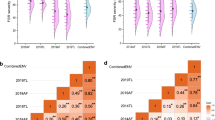Abstract
The subjectivity of index selection and unpredictable environmental variabilities cause ambiguities in multiple-trait selection across environments. In the present study, we tested and validated a recently proposed multivariate approach for genotypic selection based on multiple trait evaluations. A genotype by yield*trait (GY*T) biplot approach originally proposed was validated in this study to assess the comparative efficiency of GY*T approach over genotype by trait (GT) approach in genotypic selection on multiple traits in common bean. The analysis is based on six trials spread over four years from 2015–2018 at two locations. Based on the GY*T analysis, the biplot could improve the variation accounted for by PCI and PC2 from 71.37 to 92.81%. The genotypes WB-341, WB-1634 and WB-451 were identified as high yielding and possessed higher seed yield on account of higher values of pods per plant and seeds per pod indicating that these possess the ideal trait combination of yield, pod number and seeds per pod. The genotype WB-222 had the ideal trait combination of yield, pods per plant and plant height. Similarly the genotype WB-185 had the ideal trait combination of yield and 100-seed weight but was poor for pods per plant. The genotype WB-83 had an opposite trait profile to WB-185 especially for 100-seed weight, but was good for pods per plant, even though both had comparable yield levels. Based on the results of present study and few earlier studies, we conclude that GY*T approach based on multi-trait data is comparatively more efficient than GT biplot.


Similar content being viewed by others
Abbreviations
- DF:
-
Days to flowering
- DM:
-
Days to maturity
- PH:
-
Plant height
- NOP:
-
Pods per plant
- PL:
-
Pod length
- SPPL:
-
Seeds per pod
- 100SW:
-
100-Seed weight
- SYPP:
-
Seed yield per plant
- GT:
-
Genotype x Trait
- GY*T:
-
Genotype x Yield * Trait
References
Andersson E (1965) The selection of plus trees in Sweden. Sumarski List (Zagreb) No 1–2
Araujo KC, Vivas, M (2018) Multivariate analysis used as a tool to select snap bean (Phaseolus vulgaris L.) genotypes. Aus J Crop Sci 12(1): 67
Boureima S, Yaou A (2019) Genotype by yield* trait combination biplot approach to evaluate sesame genotypes on multiple traits basis. Turk J Field Crops 24(2):237–244
de Oliveira TRA, de Amaral GG, de Moura RM, de Alcântara NF, da Cruz DP, de Oliveira GHF, Rocha RS (2019) GYT biplot analysis: a new approach for cowpea line selection. J Exp Agri Intern 41(5):1–9
Hamid AE, Aglan MA, Hussein E (2019) Modified method for the analysis of genotype by trait (Gt) biplot as a selection criterion in wheat under water stress conditions. Egyp J Agron 41(3):293–312
Hazel LN (1943) The genetic basis for constructing selection indexes. Genetics 28(6):476–490
Kendal E (2019) Comparing durum wheat cultivars by genotype× yield× trait and genotype× trait biplot method. Chil J Agri Res 79(4):512–522
Kendal E (2020) Evaluation of some barley genotypes with genotype by yield* trait (GYT) biplot method. Agric For 66(2):137–150
Mohammadi R (2019) Genotype by yield* trait biplot for genotype evaluation and trait profiles in durum wheat. Cer Res Comm 47(3):541–551
Namkoong G (1969) Problems of multiple trait breeding. Second World Consult. Forest Tree Breeding. FAO-FO-FTB-69–7/4
Oliveira TR, Gravina AD, Oliveira GDA, Araújo GH, Araújo HC, Daher L , Cruz D (2018) The GT biplot analysis of green bean traits. Ciência Rural 48(6)
Sofi PA, Gul M, Asmat A (2020) GY*T biplot: An efficient approach for genotypic selection in multiple trait evaluations: case study of cowpea (Vigna unguiculata l.). Agri Res J 57 (2): 140–147
Xu N, Fok M, Li J, Yang X, Yan W (2017) Optimization of cotton variety registration criteria aided with a genotype-by-trait biplot analysis. Sci Rep 7(1):17237
Yan W (2014) Crop variety trials: data management and analysis. John Wiley & Sons
Yan W, Frégeau-Reid J (2018) Genotype by Yield* Trait (GY*T) biplot: a novel approach for genotype selection based on multiple traits. Sci Rep 8(1):1–10
Yan W, Frégeau-Reid J, Mountain N, Kobler J (2019) Genotype and management evaluation based on Genotype by Yield* Trait (GYT) analysis. Crop Breed Genet Genomics 1:2–21
Yan W, Rajcan I (2002) Biplot analysis of test sites and trait relations of soybean in Ontario. Crop Sci 42:11–20
Yan W, Kang M S, Ma B, Woods S, Cornelius PL (2007) GGE biplot vs. AMMI analysis of genotype-by-environment data. Crop Sci 47(2): 643–653
Acknowledgements
The financial support from department of Science & Technology, Govt. of India (Grant # SARTHI/JK/12/09) and ICAR under AICRP MULLaRP is highly acknowledged
Author information
Authors and Affiliations
Contributions
PAS = Conceived the research and design of experiment, IS, AA, KR = Executed the experiment, PAS = Analyzed the data and lead the manuscript preparation, PAS, IS, AA, KR = Helped in the manuscript preparation.
Corresponding author
Ethics declarations
Conflict of interest
The authors declare no conflict of interest.
Additional information
Publisher's Note
Springer Nature remains neutral with regard to jurisdictional claims in published maps and institutional affiliations.
Rights and permissions
About this article
Cite this article
Sofi, P.A., Saba, I., Ara, A. et al. Comparative Efficiency of GY*T Approach Over GT Approach in Genotypic Selection in Multiple Trait Evaluations: Case Study of Common Bean (Phaseolus vulgaris) Grown Under Temperate Himalayan Conditions. Agric Res 11, 373–381 (2022). https://doi.org/10.1007/s40003-021-00577-5
Received:
Accepted:
Published:
Issue Date:
DOI: https://doi.org/10.1007/s40003-021-00577-5




